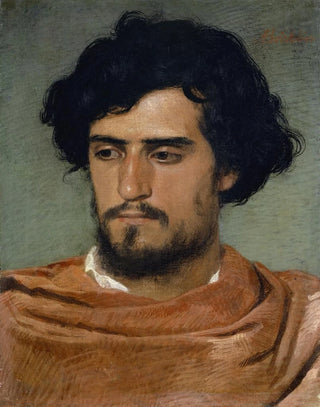Art print | Head of a Roman - Arnold Böcklin


View from behind

Frame (optional)
The "Head of a Roman" by Arnold Böcklin is a piece that captivates with its intensity and mystery. Created at the end of the 19th century, this artwork embodies the very essence of symbolism, an artistic movement that seeks to express ideas and emotions through evocative forms. By contemplating this piece, the viewer is immediately transported into a universe where history and mythology intersect, where every detail is laden with meaning. The head, with its penetrating gaze, seems to tell forgotten stories, inviting each person to explore the depths of the human soul.
Style and uniqueness of the artwork
Arnold Böcklin's style is characterized by a harmonious fusion of realism and symbolism. In "Head of a Roman," the precision of the facial features is highlighted by a subtle play of shadows and light, creating an atmosphere that is both realistic and dreamlike. The texture of the skin, the delicacy of the hair, and the expression of the gaze are all elements that contribute to the singularity of this piece. Böcklin manages to capture raw emotion, a melancholy that seems to emanate from this marble-carved head, as if time itself had stopped. This work is not merely a simple representation; it becomes a mirror of the spirit, a reflection of inner struggles and human aspirations.
The artist and his influence
Arnold Böcklin, born in 1827 in Switzerland, is an artist whose work has profoundly marked the European artistic landscape. Influenced by Romanticism and symbolism, he was able to create a unique visual language that continues to inspire many contemporary artists. His ability to fuse reality and imagination allowed him to develop a distinctive style, where nature, mythology, and humanity coexist in harmony. Böcklin also explored themes of death and transcendence, recurring motifs found in "Head of a Roman." His influence extends beyond painting, touching poetry, literature, and even cinema, demonstrating the lasting impact of his work.

Matte finish

View from behind

Frame (optional)
The "Head of a Roman" by Arnold Böcklin is a piece that captivates with its intensity and mystery. Created at the end of the 19th century, this artwork embodies the very essence of symbolism, an artistic movement that seeks to express ideas and emotions through evocative forms. By contemplating this piece, the viewer is immediately transported into a universe where history and mythology intersect, where every detail is laden with meaning. The head, with its penetrating gaze, seems to tell forgotten stories, inviting each person to explore the depths of the human soul.
Style and uniqueness of the artwork
Arnold Böcklin's style is characterized by a harmonious fusion of realism and symbolism. In "Head of a Roman," the precision of the facial features is highlighted by a subtle play of shadows and light, creating an atmosphere that is both realistic and dreamlike. The texture of the skin, the delicacy of the hair, and the expression of the gaze are all elements that contribute to the singularity of this piece. Böcklin manages to capture raw emotion, a melancholy that seems to emanate from this marble-carved head, as if time itself had stopped. This work is not merely a simple representation; it becomes a mirror of the spirit, a reflection of inner struggles and human aspirations.
The artist and his influence
Arnold Böcklin, born in 1827 in Switzerland, is an artist whose work has profoundly marked the European artistic landscape. Influenced by Romanticism and symbolism, he was able to create a unique visual language that continues to inspire many contemporary artists. His ability to fuse reality and imagination allowed him to develop a distinctive style, where nature, mythology, and humanity coexist in harmony. Böcklin also explored themes of death and transcendence, recurring motifs found in "Head of a Roman." His influence extends beyond painting, touching poetry, literature, and even cinema, demonstrating the lasting impact of his work.






